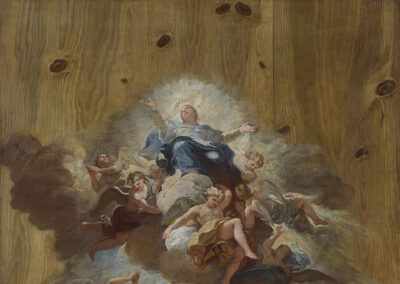Against an exquisitely rendered trompe l'oeil background, simulating a gnarled wooden panel, the Virgin, who appears to be grateful for the divine light with open arms, is lifted up to heaven through clouds by a choir of angels, while below, twelve apostles, gathered around the tomb, look on in wonder and disbelief.
As this work, for stylistic reasons, belongs to Luca Giordano's Spanish period and is already recorded in the first inventory of paintings by the IX Count of Santisteban (Cerezo San Gil, 2005), made shortly after his departure from the viceroyalty of Naples, its date of execution would have to be between 1692, when the painter arrived in Spain, and 1697, when the aforementioned inventory is dated.
Ferrari and Scavizzi (1966) derive this Assumption from the Escorial Assumption. Because of the different position and iconography of the Virgin, Pérez Sánchez considers this Escorial link to be inaccurate, and catalogues this Assumption from the Santisteban collection as belonging to the Spanish period, because of the "...".loose, vibrant design and pronounced light effects at the bottom"and relates it to a sketch of this Marian theme in the Museo del Prado (P000176), dated around 1698, which is much closer to it iconographically. Andrés Úbeda de los Cobos (2017), in his analysis of this sketch of the Assumption in the Prado, notes that Giordano, during his Spanish period, depicted the Assumption of the Virgin on various occasions and observes that in all of them the iconography of the Virgin is practically the same and that the only thing that changes is the group of apostles around the tomb. He considers that they all form a sequence that could derive from a prototype sent to Madrid in 1688 by the Viceroy Marquis del Carpio, a sequence in which this work would be the last, as it includes "...".ideas present in all the others"However, it warns that "rIt is more difficult to date, because of its small and precious detail, which does not correspond to any phase of his production.".


